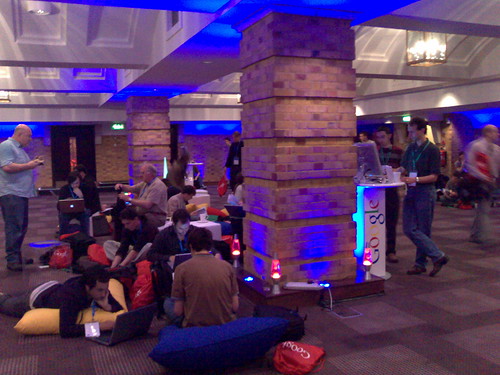After the break I'm back in Donkey Kong and listening to
What's new in Gears with Aaron Boodman.

Aaron Boodman talking about GearsThe point of Gears is to add functionality to web applications, but Gears isn't just about "offline", what Google is trying to do is expose the capabilities of the local machine, whether that's your desktop of your mobile phone, to your web applications.
Every Google Chrome installation has Gears pre-installed, but Gears now supports IE, Firefox, Opera, Safari as well as Chrome. Although the Safari port was only launched yesterday. However the latest Android build also comes with a Gears stub, not full support, but it is coming soon.
We're spending some time talking about Gears'
Desktop API and shortcut icons, and the
File System API. The file system allows multi-file selection, fitering my extension or mime-type, native OS look-and-feel and makes sure the user has full control...
Obviously what you want to be able to do when you select a file, you want to do something with the contents of the file, and web applications can't. Which is what
the Blob is for, it's a generic interchange format.
Next up is the
Resumable Upload API which sits onto of the Blob API, which is apparently now live on
YouTube. You can in theory parallelize the upload, but most browsers have a fairly low connection limit per-domain, so you can parallelize uploads up to that limit.
I'm going to use Chrome, because they told us to use Chrome as much as possible. But it does work on the other browsers...
Perhaps one of the coolest of the new APIs is the
GeoLocation API, which can make use of on-board GPS, cell-phone tower and Wi-Fi access point triangulation. But developers can implement plug-ins to provide more methods of location. It should degrade cleanly, the API will provide the best guess of the user's location to your code.
What's next for Gears? More of the same, continue to unlock the capabilities of the host system.
...we're out of slides, and the floor is open for questions.
is there any plans to allow applications to share data between domains? This is a problem Google has, and initially they thought about sharing databases together, but that seems like a recipie for disaster. What Gears has is
Cross-origin Workers, a secure solution to the cross-origin restriction policy of the browser.
...and we're breaking for lunch. Still not sure whether I'll end up in a code lab or the main tracks for the rest of the afternoon.





















